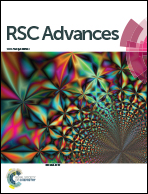Theoretical investigation on the balance between large band gap and strong SHG response in BMO4 (M = P and As) crystals†
Abstract
Nonlinear optical (NLO) materials with outstanding performances are particularly important in laser science. To design an efficient NLO material with an optimal balance between the optical band gap and the NLO coefficient is still a huge challenge. In this paper, the electronic structures and optical properties of two isostructural non-centrosymmetric BMO4 (M = P and As) crystals exclusively containing tetrahedral groups have been studied by the first-principles method. Our calculated results show the compounds exhibit excellent properties with a suitable balance of large band gap and large NLO coefficient for BPO4 (10.4 eV and 0.64 pm V−1) and BAsO4 (7.8 eV and 1.58 pm V−1). The unanticipated large second-harmonic generation (SHG) response can be understood by the relatively strong s–p hybridization in BMO4 (M = P and As). It is found that substitution of PO4 groups for AsO4 groups can increase the SHG effect and the birefringence but decrease the band gap. Whether the redshift of bandgap will be responsible for the change of SHG effect between BMO4 (M = P and As) is explored by energy correction method. The increased polarizability anisotropy of tetrahedral groups explained the enhanced birefringence.


 Please wait while we load your content...
Please wait while we load your content...